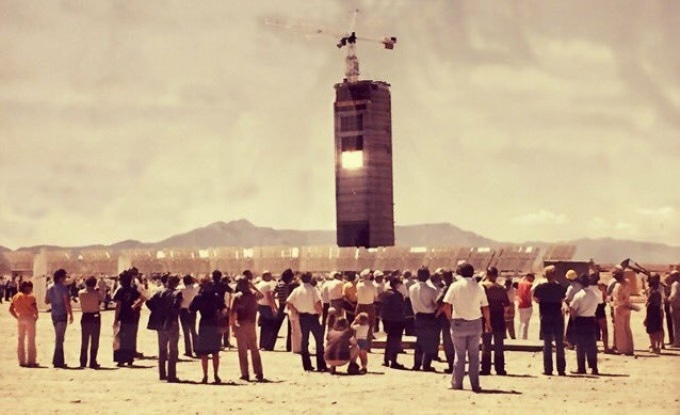Jul 27 2018
The world’s first multimegawatt solar tower, which was commissioned at Sandia National Laboratories in July 1978, has contributed to space exploration, energy research, solar energy commercialization, and defense testing—from testing space shuttle tiles to generating electricity from sunlight.
 In 1978, Sandia National Laboratories began concentrating solar power research at the newly constructed National Solar Thermal Test Facility. Sandia is celebrating its 40th anniversary this month. (Photo courtesy of Sandia National Laboratories)
In 1978, Sandia National Laboratories began concentrating solar power research at the newly constructed National Solar Thermal Test Facility. Sandia is celebrating its 40th anniversary this month. (Photo courtesy of Sandia National Laboratories)
The solar tower is a major component of a particular type of utility-scale solar energy technology that utilizes hundreds of big mirrors to reflect and focus sunlight onto a receiver on a tower. From the concentrated sunlight, the heat is absorbed by a solid, liquid, or gas and then stored or utilized instantly in a heat exchanger to produce electricity. Energy of this type, known as concentrating solar power, is attractive as it can provide renewable energy - even when there is no sunlight - without the help of batteries for storage.
On the occasion of the National Solar Thermal Test Facility’s 40th anniversary this month, past and present Sandia researchers and leaders, government representatives, and industry leaders are joining together for a day of talks and tours focused on the facility’s history, and its role in solar energy and other fields and the present research perspective.
Paul Gauche, concentrating solar power manager of Sandia, stated that the Department of Energy supported the development of the solar tower and the surrounding National Solar Thermal Test Facility at Sandia in the late 1970s, when the oil crisis was at its peak and photovoltaic solar energy and concentrating solar power were novel ideas.
Concentrating solar power was a big deal during the later parts of the oil crisis. The funding for research through the early 80s was, put in terms of 2018 dollars, somewhere in the region of $100 million to $200 million a year nationwide. Funding levels have varied, but the U.S. has continued to consistently invest in concentrating solar power through the years.
Paul Gauche, Concentrating Solar Power Manager of Sandia
Initially, when it was built, the solar tower was equipped with a large steam receiver in order to absorb the heat from concentrated sunlight to show and research the ability of multimegawatt tower-based concentrating solar power technology. Previously, other groups have carried out research with kilowatt-based tower designs and parabolic trough designs.
Gauche added that in 1981, the Sandia research resulted in collaboration with a rocket manufacturer, Rocketdyne¸ to create Solar One, which became the first operating solar tower in the world. An operating tower is capable of delivering power to the electrical grid, though not on a commercial basis.
There are three main steps that were achieved. Sandia had the research tower, which led to developing the first operating tower, and then there was commercialization as industry began to build and operate their own towers.
Paul Gauche, Concentrating Solar Power Manager of Sandia
Based in Barstow, California, Solar One used a steam receiver and had approximately 10 times more mirror-like heliostats than the research tower at Sandia, giving it an electric output of 10 megawatts. Gauche stated that in 1995, Rocketdyne and Sandia converted it to Solar Two, which had a molten salt receiver. Salts that are heated to a high temperature and converted into a liquid are called molten salts. By flowing through a receiver, the hot salts absorb heat from sunlight and can be subsequently stored in a tank until required for the generation of electricity.
“This was the first demonstration of energy storage with concentrating solar power,” said Gauche. “It delivered storage-based solar electricity to the grid in Southern California.”
Speaking of the decommissioning of Solar Two in 1999, Gauche added, “it was a demonstration, and it had proved the point that concentrating solar power could work for utility-scale electricity generation.”
At the National Solar Thermal Test Facility, Sandia’s solar tower continued to be a research hub for concentrating solar power with Solar One and Solar Two operating, but its ability to produce high radiation flux from sunlight has also been valuable for other applications.
Sandia has diversified the facility and used the tower to test space shuttle tiles and ablative materials used for landers going to Saturn. We’ve also done testing for the Air Force and other agencies for national security purposes.
Paul Gauche, Concentrating Solar Power Manager of Sandia
Concentrating solar power research has also continued to progress. At present, Sandia is heading one of three teams chosen by the DOE’s Solar Energy Technologies Office to compete to construct a high temperature concentrating solar power system with integrated heat storage. The system proposed by Sandia employs sand-like ceramic particles for absorbing and storing the heat from the concentrated sunlight.
Sandia has already pioneered the development of the world’s first high-temperature falling particle receiver, and this study will refine and incorporate that system into a complete pilot plant. Besides that, Sandia is a partner on the team led by National Renewable Energy Laboratory, which is researching on the capabilities of higher temperature molten salt. This means that the National Solar Thermal Test Facility is the prospective host site for two teams that could be chosen to build and test a pilot over a period of five years.